[/caption]
Ten years ago today the Russian built Zarya control module was launched into space and the International Space Station was born. The orbiting outpost has gone from one small module to an expansive station with ten different modules made in several different countries, a huge backbone truss structure made of 12 large pieces, and three sets of the largest solar arrays ever sent into space. The current space shuttle mission is providing the furnishings to outfit the station into a five-bedroom, two bath, two kitchen space research outpost. 164 people have visited the station in these past ten years, as the 313 ton station has circled the Earth more than 57,300 times and traveled a distance of more than 1.3 billion miles (2 billion km). See a very nifty animation of how the station was built at USA Today, see a list of all the flights so far dedicated to ISS construction, and find all the stats you’ll ever want on the ISS here.
Frequent readers of Universe Today know I have a soft spot in my heart for the ISS, and today I’d like to share some of my favorite images from the past ten years of station construction. Above is a collage of the Zarya module a decade ago, (left) and the station’s current configuration.
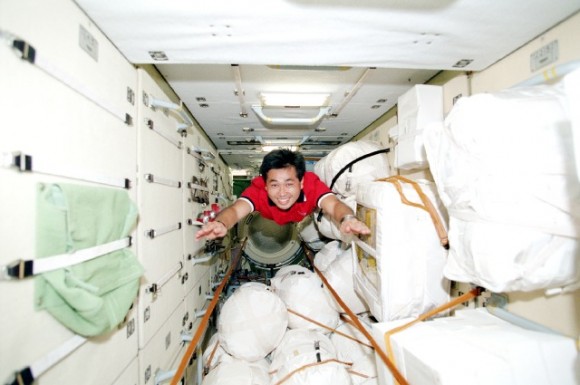
Before the station could house its first occupants, it took several missions to outfit the ISS and bring up supplies. Here, astronaut Koichi Wakata from Japan floats through the Zvezda module in October of 2000, which the STS-92 crew stocked almost completely with supplies for the first crew. Permanent occupancy began just a few weeks later when the Expedition One crew of Bill Shepherd, Yuri Gidzenko, and Sergei Krikalev opened the ISS hatch on Nov. 2, 2000.
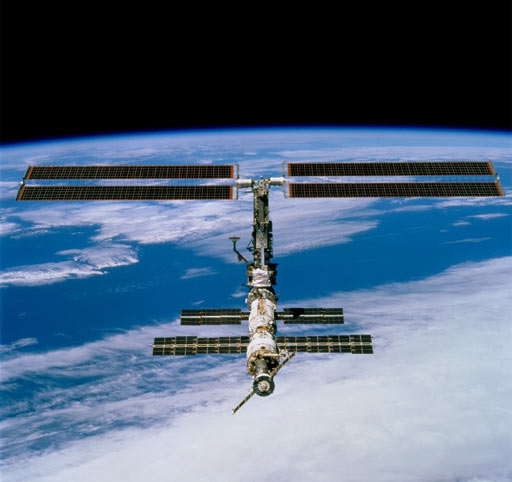
Shortly after the Expedition One crew arrived, the STS-97 space shuttle crew visited and installed the P6 Truss, which contains the first set of the huge solar arrays. The P6 provided enough solar power so that that soon afterward, the first laboratory could be installed. The P6 was temporarily installed on top of the Z1 Truss in December 2000.
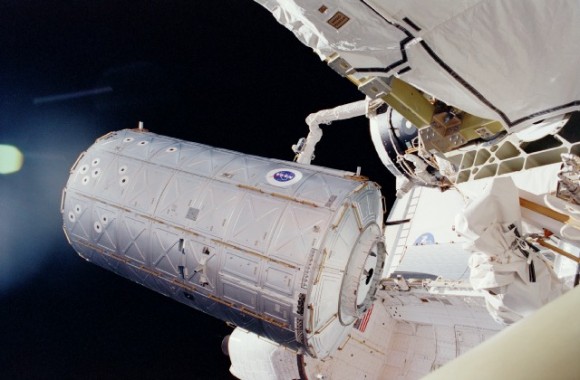
In February of 2001 space shuttle Atlantis brought up the Destiny Laboratory. Here, the lab is in the grasp of the shuttle’s remote manipulator system (RMS) robot arm, moving it from its stowage position in the shuttle’s cargo bay and attaching it to the ISS.
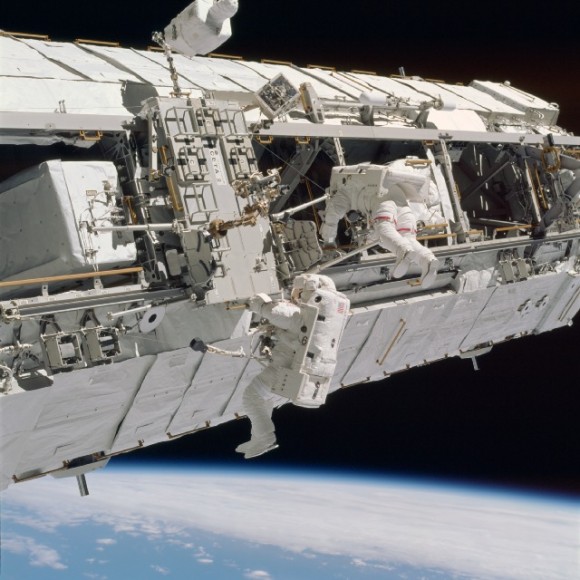
The truss sections make up the “backbone” of the station. Most of the trusses are huge in themselves, some weighing 27,000 pounds. But together, they expand the station’s length to the size of a football field. Here in November 2002, Astronauts John Herrington (left) and Michael Lopez-Alegria from the STS-113 shuttle crew, work on the newly installed Port One (P1) truss. This mission activated the “railcar” on the truss, allowing astronauts to move easily up and down the truss for construction and maintenance. The station’s robotic arm (SSRMS) can also be attached to the car.
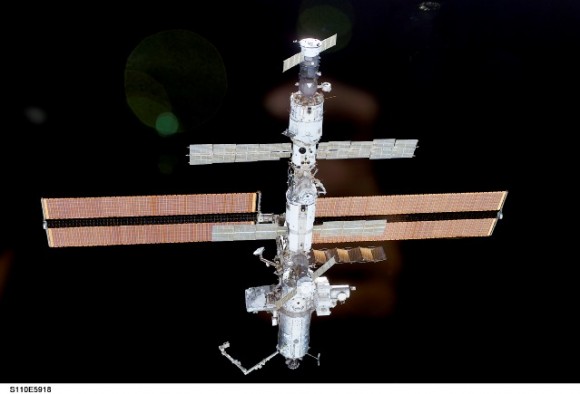
Backdropped by the blackness of space and Earth’s horizon, this full view of the International Space Station was photographed by the departing Space Shuttle Discovery crew following undocking after a construction mission in August of 2005.
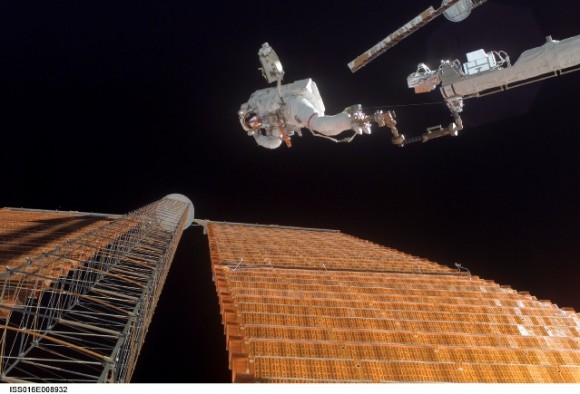
In an emergency operation, astronaut Scott Parazynski anchored himself to a foot restraint on the end of the Orbiter Boom Sensor System to repair a torn solar array during the STS-120 in October of 2007. Parazynski cut a snagged wire and installed homemade stabilizers designed to strengthen the damaged solar array’s structure and stability after it was torn while re-deploying the array after it was moved to its permanent position.
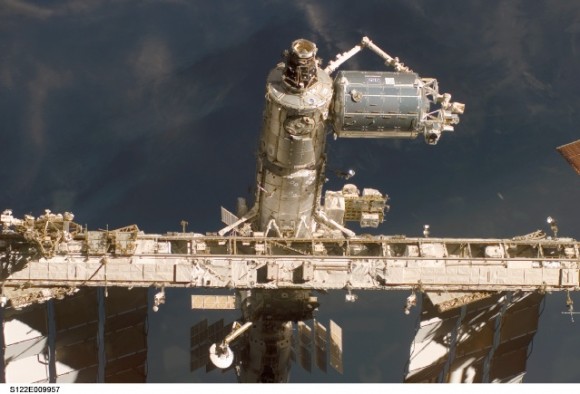
A close-up view of the shiny new Columbus laboratory (top right), added during the STS-122 mission in February 2008, photographed by Space Shuttle Atlantis crew shortly after the undocking of the two spacecraft.
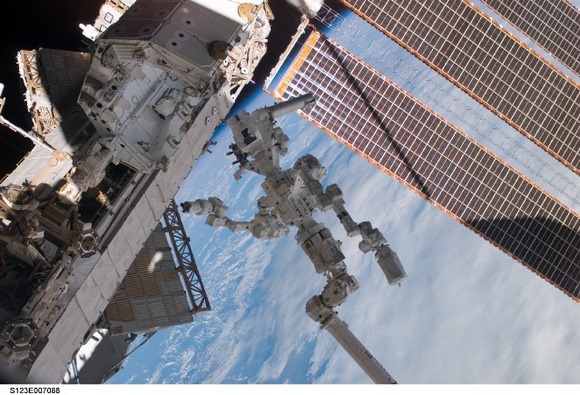
In March of 2008, astronauts installed a large robot named Dextre outside the station. The two-armed, $200-million robot will reduce the amount of time astronauts must spend outside the space station, and could eliminate the need for up to a dozen spacewalks a year. Here’s a comparison between Dex and Hal.
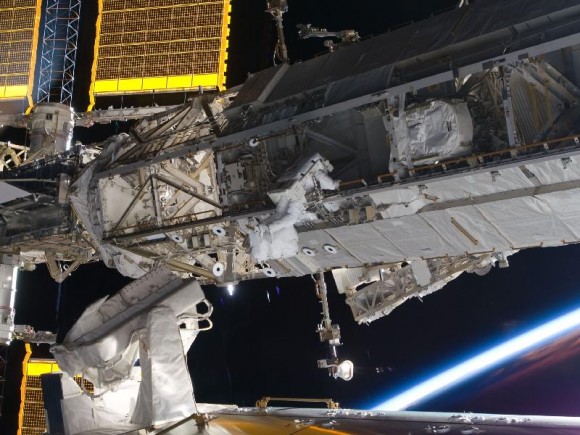
And finally, here’s a new image from the latest STS-126 mission. Astronauts Steve Bowen and Heidemarie Stefanyshyn-Piper (out of frame) worked to clean and lubricate part of the station’s starboard Solar Alpha Rotary Joints (SARJ) and to remove two of SARJ’s 12 trundle bearing assemblies. The spacewalkers also removed a depleted nitrogen tank from a stowage platform on the outside of the complex and moved it into Endeavour’s cargo bay. They also moved a flex hose rotary coupler from the shuttle to the station stowage platform, as well as removing some insulation blankets from the common berthing mechanism on the Kibo laboratory.


Nancy,
Good article, and some great pictures.
But the hominid spaceflight, and the ISS project, remains an enormous waste of time, energy, and money.
Beautifull !!!
This is one of the best articles all year!
I guess I’ve been asleep, I did not realize they’ve increased the size of the space station to this scale. 100 yards long! That’s huge.
Thanks for this article.
We don’t just need to talk about spaceflight, we need practice. We practice on the ground, we practice in orbit, we practice on the moon.
In that regard its not a waste.
100billion over 10years shared between a bunch of countries does not seem like that huge an amount of money to be sinking into a project of such vast scale.
If you want to talk about waste of money, talk about the 350billion that has virtually disappeared god knows where… and that was done in what, 3 weeks???
When the ISS does more than need constant repairs and the stories are bigger than lost tool bags and spiders, then I might be enthralled with the station.
We were supposed to have a giant wheel in space, launching missions to the Moon and Mars. And I mean that literally, not the way some pretend it is suppose to help us get there.
As to the arms, why are they called robotic arms? They are under direct human control. That makes them waldoes not robots. Robots are autonomous.
Gorgeous shots
Next stop, Luna!
That’s never a shot of the current configuration on the right hand side! Okay, Collumbus and Kibo are in place but the ATV is still docked. (am I being a little pedantic here?)
;- )
Amazing!!!
Amazing at the heights of human brain!!
And cant stop amazing at the vastness of universe!!
Salutes to the ISS crew and astronauts!!
I thought I was the only ISS nut.
Glad others like the ISS.
Hooo Its Amazing the International Space Station ……………… in Dreams we can go anywere… but in real life we can’t?……